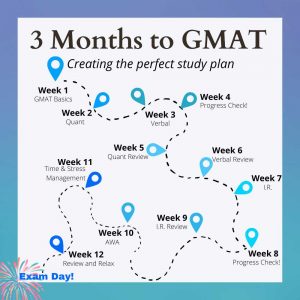1. Introducing the GMAT
When beginning your GMAT journey, the first step you need to do is figure out why you are taking the GMAT and what your future MBA goals are. If you are hoping to attend a top-tier Business School, like Harvard, this will make your GMAT preparation different compared to a goal of attending a part-time, online MBA program. Keep in mind that effort will still need to be given no matter which program you decide to apply to. Regardless of your ultimate goal, it is important to have your final goal in mind before laying out your GMAT preparation plan. So, once you have established why you are taking the exam, next is creating a plan of how to prepare for the GMAT.
2. Know the GMAT inside and out
One of the first things you want to do is to get comfortable with the GMAT exam and its structures. The GMAT is split up into four sections:
- Analytical Writing Assessment (AWA) → to measure your critical thinking and communication skills
- Integrated Reasoning → to measure your data analysis skills
- Quantitative Reasoning → to measure your ability to draw conclusions from present data
- Verbal Reasoning → to measure your reading, evaluation, and correction skills in standard English
By splitting up the GMAT into its four main sections, you can begin your preparation process more fluidly. Recognize your strengths and weaknesses in each of these sections and dedicate yourself to strengthening your weaknesses and solidifying your strengths. In order to know where you stand with the GMAT, we always suggest taking a practice exam before beginning to prepare. This will give you a baseline knowledge of where you stand with each section of the exam.
3. Lay out a 3-month GMAT study plan
 Ideally, you give yourself 3-months to study for the exam. We have created a 3-month study plan which can be used by most test-takers when beginning their GMAT journey. Ultimately, giving yourself 3-months means you have room to get to know every aspect of the exam. Give yourself less than 3-months and you will be hindering your chances of success. We suggest finding the date of your GMAT exam (giving yourself an extra week or two for a retake – just in case) and counting backwards by 3 months. Then, mark your calendar in the following way:
Ideally, you give yourself 3-months to study for the exam. We have created a 3-month study plan which can be used by most test-takers when beginning their GMAT journey. Ultimately, giving yourself 3-months means you have room to get to know every aspect of the exam. Give yourself less than 3-months and you will be hindering your chances of success. We suggest finding the date of your GMAT exam (giving yourself an extra week or two for a retake – just in case) and counting backwards by 3 months. Then, mark your calendar in the following way:
During your study plan, it is important that you make time for stress relief. Do not let the GMAT preparation process consume you. Being stressed will do you no favors in the long run and could even negatively impact your overall GMAT score.
4. It’s okay to ask for help
Believe it or not, we expect successful GMAT test takers to have asked for help during their journey. Whether it is from their friends or family or even hiring a private GMAT tutor, many people who achieve a 700+ GMAT score do so because they have had some sort of help. Even asking a previous GMAT test taker how to prepare for the GMAT can be a huge help! A private GMAT tutor, for example, can help you achieve GMAT success by working with you in a myriad of ways.
Whether it is by helping you to strengthen your weaknesses or fortifying your strengths, a good GMAT tutor will be able to recognize where you need help and how best to help you. Make sure that, if you need help you don’t wait until the last minute to ask for it. Be ready to ask for help as soon as you begin your studies.
5. Be confident and remember your goal
It is common practice for people who take the GMAT to question their rationale for undertaking such a journey. The GMAT is not supposed to be an easy exam (if it was easy, then everyone would do it!). But you are one of those select few who choose to go down this difficult path. We suggest surrounding yourself with a strong support network. Stress reduction is also hugely important during this journey, be careful not to get burned out too soon as this can ultimately hinder your GMAT exam process.
Final Thoughts
We here at Apex know the difficulty of figuring out how to prepare for the GMAT exam. We work with clients from a variety of different backgrounds and tutor them to GMAT success. Whether you are about to begin your GMAT journey or are already two months in, we are in the business of helping anyone who wants to achieve an elite GMAT score. We offer 30-minute complimentary consultation calls with one of our top-scoring instructors.
Contributor: Dana Coggio
